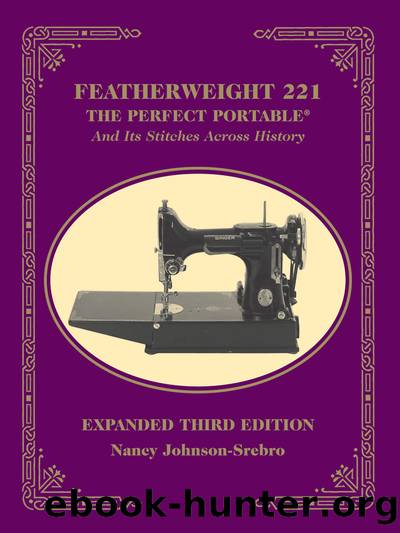Featherweight 221 by Nancy Johnson-Srebro

Author:Nancy Johnson-Srebro
Language: eng
Format: epub
Publisher: C&T Publishing
Model 68 Cabinet in use
Photo by Dale Pickens and Bobâs Picture Box
What are they worth today? Iâm going to say that I really donât know. Iâve come across a very few of the Model 68 Cabinets in my travels, and none of them were for sale. However, in coming years more examples should come to light as people start looking for the âend tableâ that fits a Featherweight. And Iâm sure some will start changing hands. This will give us something to go by when trying to establish their current value.
Who Made Them?
Iâve often been asked who made the wooden cabinets, tables, stands and sewing stools for Singer. Thereâs a prevalent feeling that they were manufactured by one or more suppliers. Several people have even written to me in hopes of locating a warehouse with long forgotten Card Tables or even parts. No . . . . the short answer is that Singer made most of them itself. This was dictated by high sales volumes and stringent quality specifications. Wood was used in the pre-plastics days and there was a huge demand for the forest resource. So, Singer had its own sawmill and cabinetwork plant, located in Thurso, Quebec. And, believe it or not, the volume of wood cut-offs and chips was so large that a small Kraft pulp mill was operated on the same site to process what would otherwise be waste.
My husband was traveling on business a few months ago and he was in Ottawa, Ontario. Thurso is located a few miles from there, so he visited the town. Frank talked with residents, former employees, and some folks who work at the present-day pulp mill and sawmill. He learned they were sold by the parent company many years ago, and are now separately owned. Both are doing well, although neither industry is apparently involved in the sewing machine woodwork business at present.
Utility Table Repairs
The Singer Card Tables and their Extension Sets were well designed and built and theyâve stood up well considering the rigors many were subject to over the years. Other than paint touch-up here and there, only two areas of repair are likely.
The first one is relatively simple. Once the insert is removed, the Featherweight presses into spring clips that position and hold it while in the Table. These clips were originally faced with leather or felt to protect the machine from scratching. On many tables, the facings are badly worn or even missing. Repairs can be easily made using leather from a discarded shoe, or felt that can be readily purchased. Most craft glues will do, just be sure to check the label to see if itâs good for leather/felt and metal.
The second problem is more serious and it merits long and careful thought. The top of the Card Table or Extension Set may be worn excessively, or its veneer may be delaminating. Now Iâm not talking here about a few scratches, wear marks or even burns from hot cooking pans - these are reasonable and should be expected.
Download
This site does not store any files on its server. We only index and link to content provided by other sites. Please contact the content providers to delete copyright contents if any and email us, we'll remove relevant links or contents immediately.
vogue knitting beginner basics by Unknown(1087)
280 Japanese Lace Stitches by Nihon Vogue(1037)
KNIT - Vogue Knitting on the go by Socks(922)
Knitting for Beginners: Learn How to Knit Quickly and Easily From Home (Knitting Books - Master this Amazing Craft and Knit Beautiful Patterns) by Victoria Lane(822)
The Pocket Guide to Fishing Knots: A Step-by-Step Guide to the Most Important Knots for Fresh and Salt Water - PDFDrive.com by Joseph B. Healy(663)
Ultimate Book of Everyday Knots by Geoffrey Budworth(562)
Crochet Collage Garden by Chris Norrington(546)
55 Fantastic Japanese Knitting Stitches by Kotomi Hayashi(531)
100 Crochet Tiles by Various(525)
50 THINGS TO KNOW ABOUT KNITTING by Fanelli Christina(507)
The Ultimate All-Around Stitch Dictionary by Bernard Wendy;(504)
Spooktacular Crochet by Annie's(489)
Better Homes & Gardens Can It! by Unknown(474)
Ultimate Illustrated Guide to Sewing Clothes by Mahon Joi;(469)
Traditional Knitting Patterns by James Norbury(465)
Cross Stitch Collection by Unknown(463)
First Time Embroidery and Cross-Stitch by Wyszynski Linda;(442)
Crochet Your Own Kawaii Animal Cuties by Katalin Galusz(441)
The Tunisian Crochet Handbook: A Beginnerâs Guide by Toni Lipsey(436)
